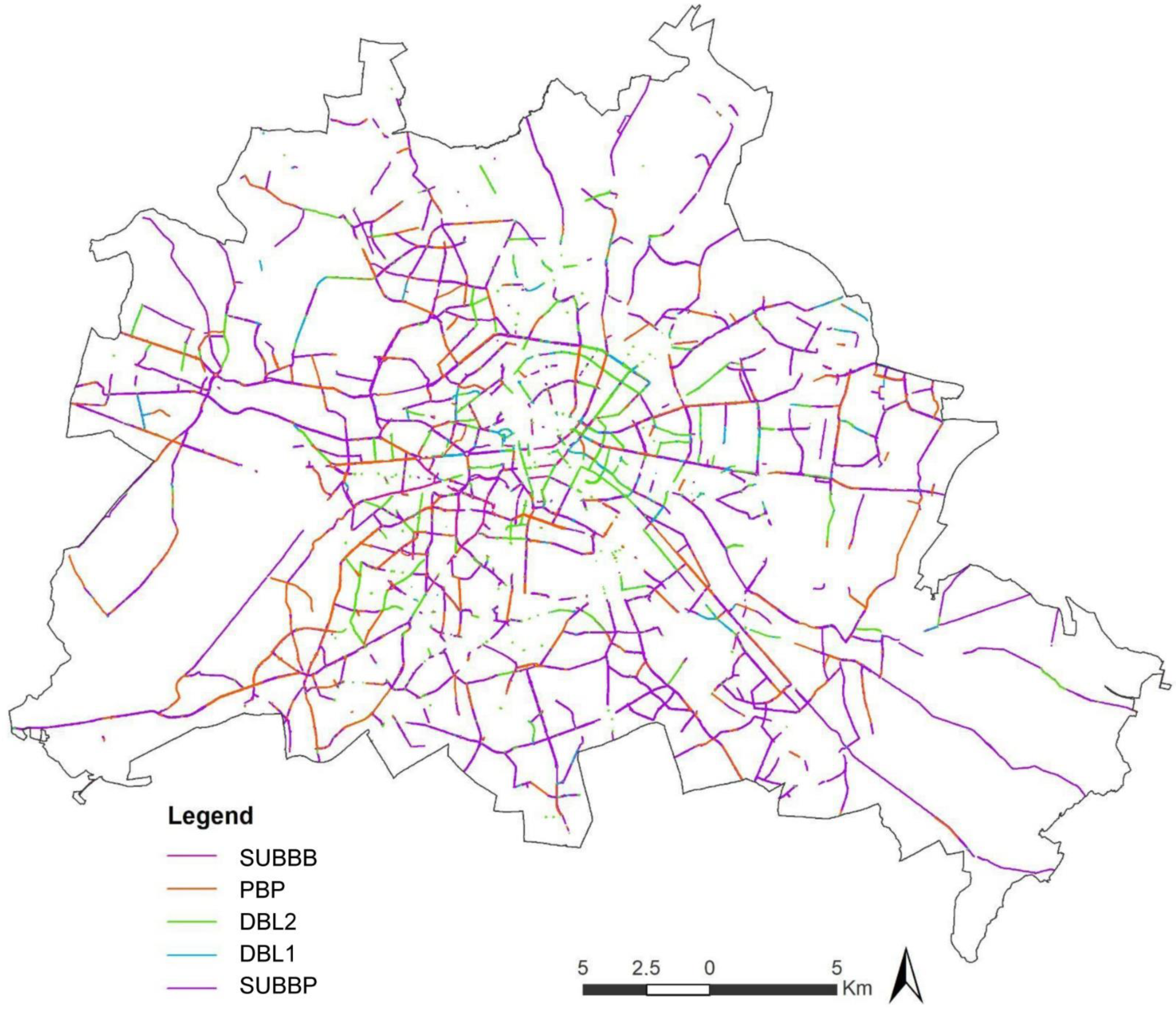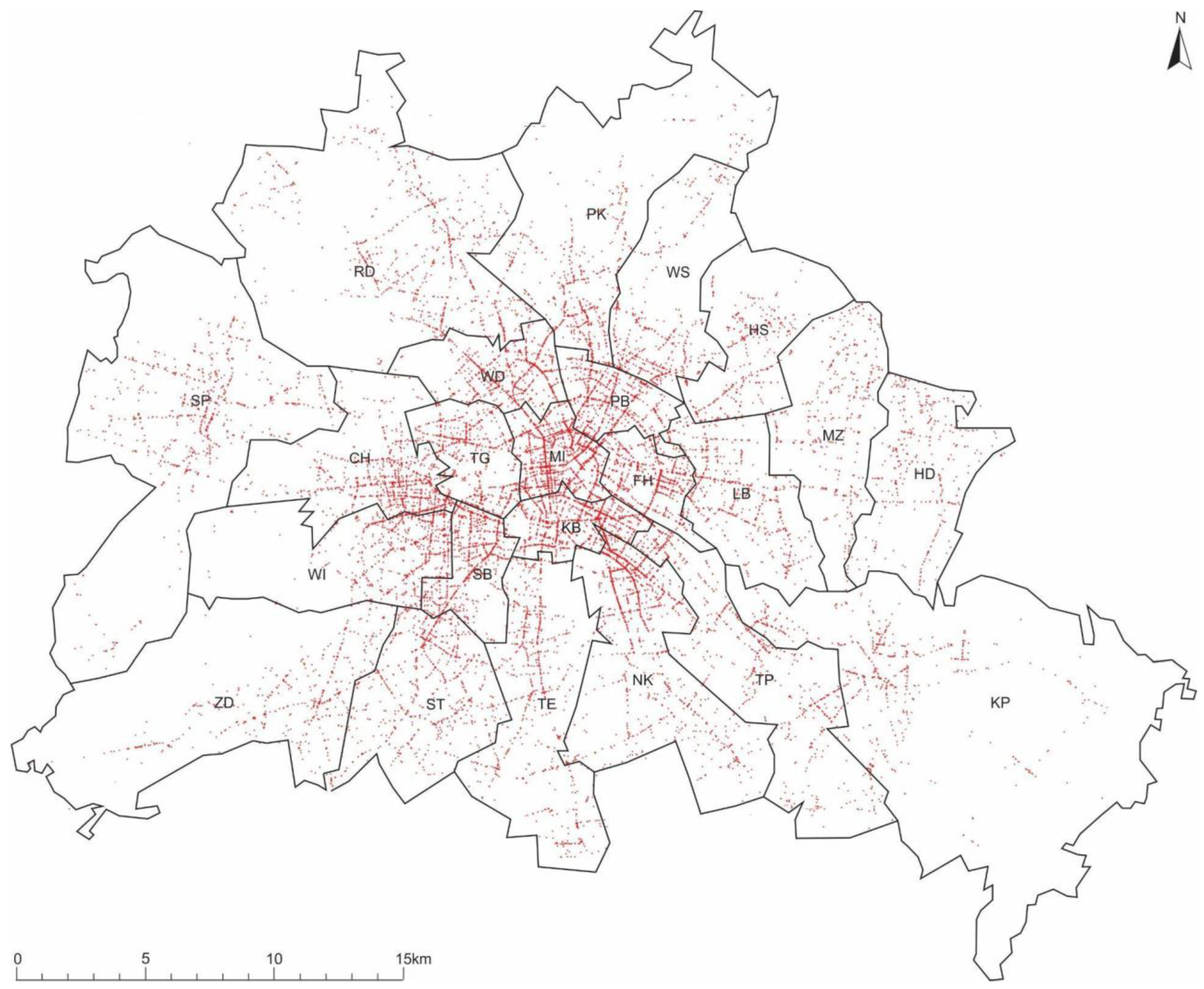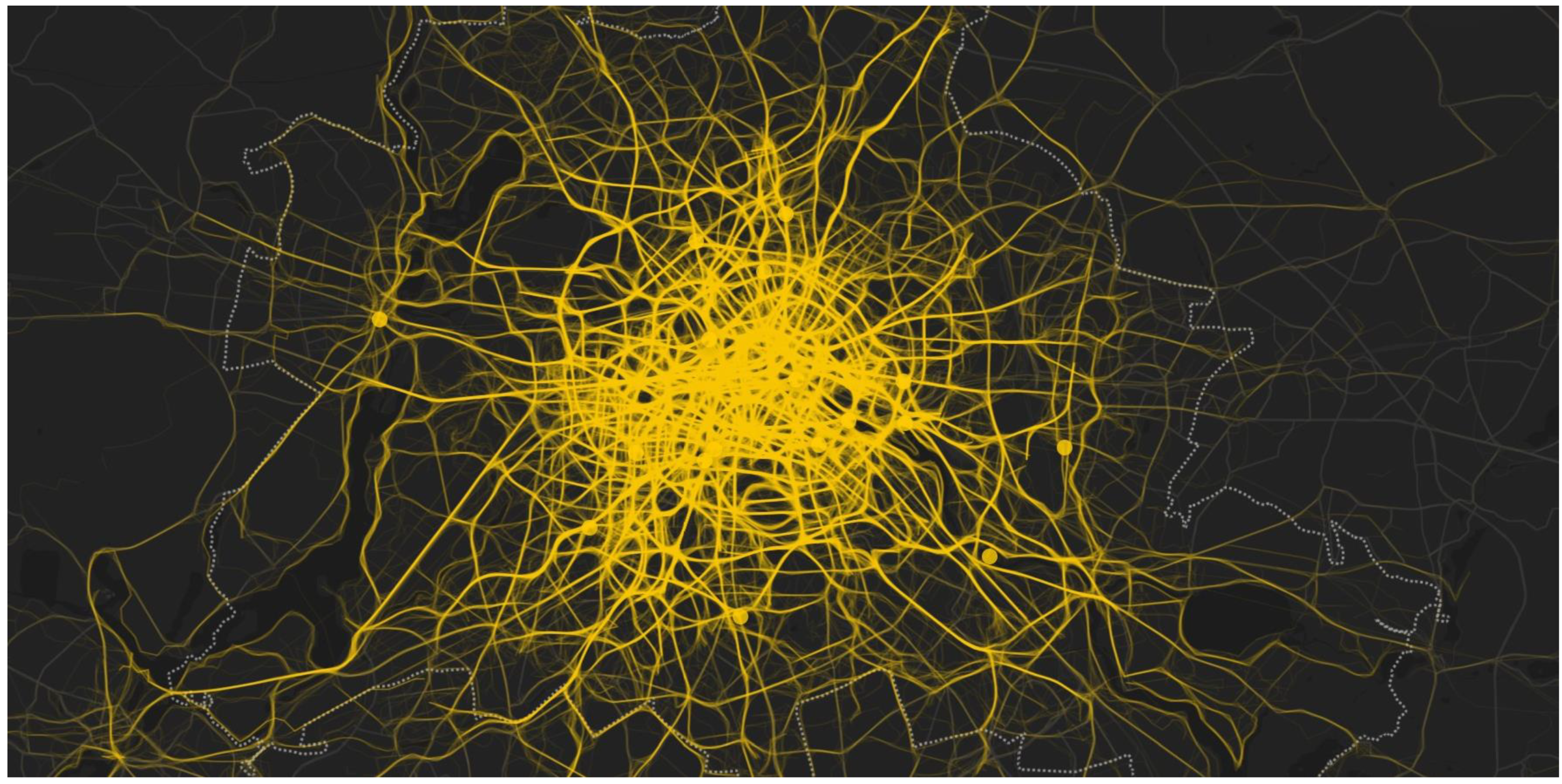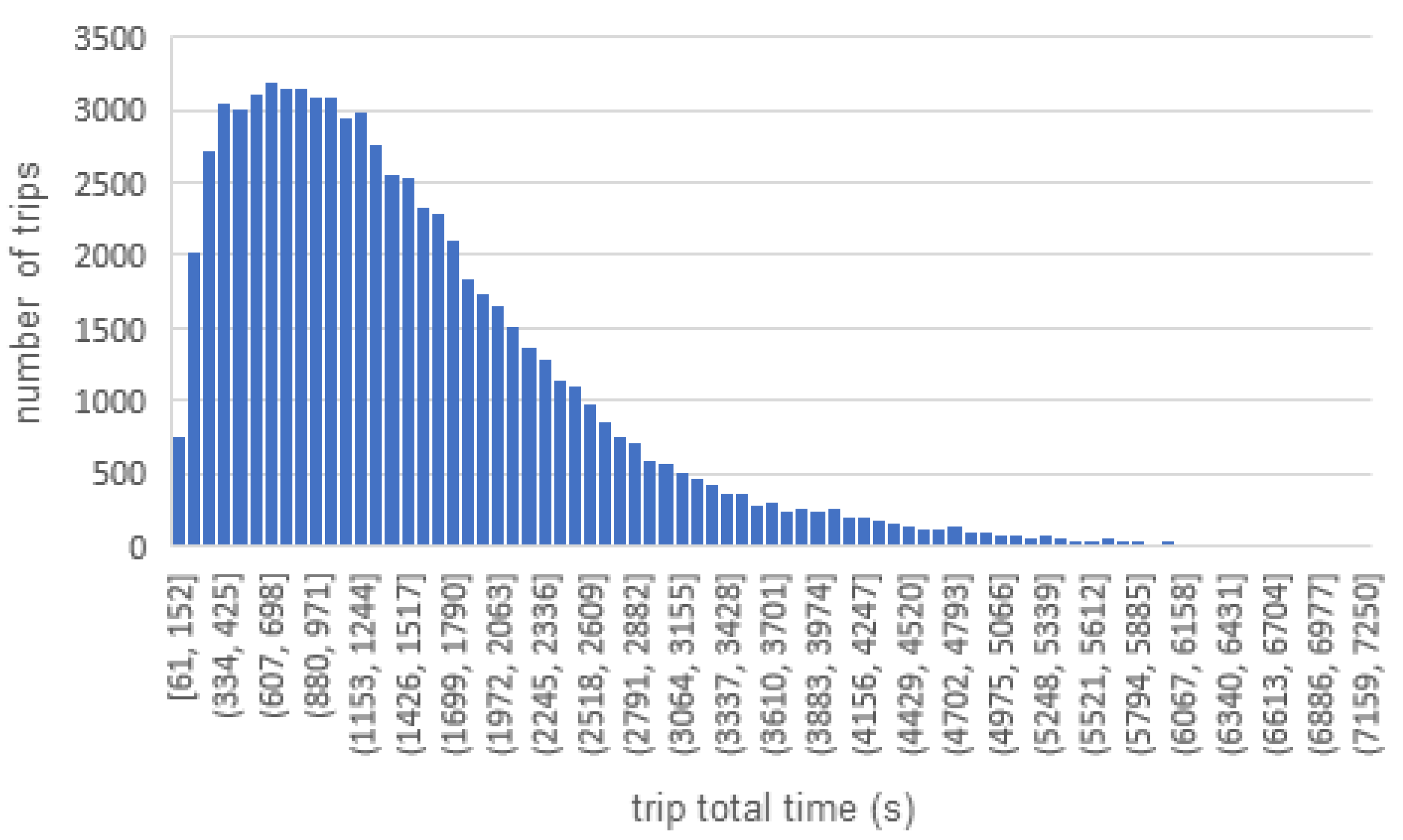Spatiotemporal Variation in Bicycle Road Crashes and Traffic Volume in Berlin: Implications for Future Research, Planning, and Network Design
Abstract
:1. Introduction
2. Previous Work
3. Methods and Data Digitalization
4. Results and Discussion
4.1. Spatial Correlation of Bicycling Crashes and Bikeway Types
4.2. Spatiotemporal Analysis of Bicycle Traffic and Bicycling Trip Behavior
4.3. Relationships between Bicycling Crashes and Traffic Volumes
5. Conclusions
5.1. Implications for Designing Future Networks
5.2. Implications for Future Planning
5.3. Implications for Future Research
Author Contributions
Funding
Institutional Review Board Statement
Informed Consent Statement
Data Availability Statement
Acknowledgments
Conflicts of Interest
References
- Hong, J.; McArthur, D.; Raturi, V. Did Safe Cycling Infrastructure Still Matter During a COVID-19 Lockdown? Sustainability 2020, 12, 8672. [Google Scholar] [CrossRef]
- World Health Organization. Supporting Healthy Urban Transport and Mobility in the Context of COVID-19; World Health Organization: Geneva, Switzerland, 2020. Available online: https://www.who.int/publications/i/item/9789240012554 (accessed on 25 June 2021).
- Abdullah, Z. Singapore’s E-Bike Numbers Double over the Past Year Amid Demand from Food Delivery Riders. Channel New Asia. 25 June 2021. Available online: https://www.channelnewsasia.com/news/singapore/e-bike-numbers-double-singapore-demand-food-delivery-riders-15067674 (accessed on 25 June 2021).
- Buehler, R.; Pucher, J. COVID-19 Impacts on Cycling, 2019–2020. Transp. Rev. 2021, 41, 393–400. [Google Scholar] [CrossRef]
- Oltermann, P. Berlin Reports Rise in Fatalities as New Bike Lanes Fail to Keep Cyclists Safe. The Guardian. 24 August 2020. Available online: https://amp-theguardian-com.cdn.ampproject.org/v/s/amp.theguardian.com/world/2020/aug/24/berlin-reports-rise-in-fatalities-as-new-bike-lanes-fail-to-keep-cyclists-safe?amp_js_v=a3&_gsa=1&usqp=mq331AQFKAGwASA%3D#referrer=https%3A%2F%2Fwww.google.com& (accessed on 25 June 2021).
- Schröter, B.; Hantschel, S.; Koszowski, C.; Buehler, R.; Schepers, P.; Weber, J.; Wittwer, R.; Gerike, R. Guidance and Practice in Planning Cycling Facilities in Europe—An Overview. Sustainability 2021, 13, 9560. [Google Scholar] [CrossRef]
- Rietveld, P.; Daniel, V. Determinants of bicycle use: Do municipal policies matter? Transp. Res. Part A Policy Pract. 2004, 38, 531–550. [Google Scholar] [CrossRef]
- Buehler, R.; Pucher, J. Cycling for Sustainable Cities; MIT Press: Cambridge, MA, USA, 2021. [Google Scholar]
- Wijnen, W.; Schroten, A.; Hoen, M. The Cost of Road Crashes in the Nederlands: An Assessment of Scenarios for Making; CE Delft: Delft, The Netherlands, 2016. Available online: https://trimis.ec.europa.eu/sites/default/files/project/documents/thecostofroadtrafficaccidentsinthenetherlands.pdf (accessed on 2 November 2021).
- Medeiros, R.M.; Duarte, F. Policy to promote bicycle use or bicycle to promote politicians? Bicycles in the imagery of urban mobility in Brazil. Urban Plan. Transp. Res. 2013, 1, 28–39. [Google Scholar] [CrossRef]
- Pucher, J.; Dill, J.; Handy, S. Infrastructure, programs, and policies to increase bicycling: An international review. Prev. Med. 2010, 50, S106–S125. [Google Scholar] [CrossRef]
- Hughes, T.P. The evolution of large technological systems. In The Social Construction of Technological Systems: New Directions in the Sociology and History of Technology; MIT Press: Cambridge, MA, USA, 1987. [Google Scholar]
- Bijker, W.E. Of Bicycles, Bakelites, and Bulbs: Toward a Theory of Sociotechnical Change; MIT Press: Cambridge, MA, USA, 1997. [Google Scholar]
- World Health Organization. Global Status Report on Road Safety 2015; WHO: Geneva, Switzerland, 2015. [Google Scholar]
- Buehler, R.; Dill, J. Bikeway Networks: A Review of Effects on Cycling. Transp. Rev. 2016, 36, 9–27. [Google Scholar] [CrossRef]
- Ebert, A.-K. Radelnde Nationen: Die Geschichte des Fahrrads in Deutschland und den Niederlanden bis 1940; Campus Verlag: Frankfurt, Germany, 2010. [Google Scholar]
- Briese, V. Radwege-Fluchtraeume oder Hindernisparcours. Z. Verk. 2011, 61. [Google Scholar]
- Medeiros, R.M. Obduracy and Change in Urban Mobility Sociotechnical Ensembles Involving Information and Communication Technologies. Ph.D. Thesis, Technische Universität Berlin, Berlin, Germany, 2018. [Google Scholar]
- Berlin Senate. Berlin Senatsverwaltung für Umwelt, Verkehr und Klimaschutz. Tabellenbericht zum Forschungsprojekt Mobilität in Städten—SrV 2018 in Berlin. 31 January 2020. Available online: https://www.berlin.de/sen/uvk/_assets/verkehr/verkehrsdaten/zahlen-und-fakten/mobilitaet-in-staedten-srv-2018/berlin_tabellen_berlin_gesamt.pdf (accessed on 25 June 2021).
- Berlin Senate. Senatsverwaltung für Stadtentwicklung und Umwelt: Tabellenbericht zum Forschungsprojekt Mobilität in Städten—SrV 2013 in Berlin. 2014. Available online: https://www.berlin.de/sen/uvk/_assets/verkehr/verkehrsdaten/zahlen-und-fakten/mobilitaet-in-staedten-srv-2013/srv_2013_berlin_tabellen.pdf (accessed on 10 May 2017).
- Abduljabbar, R.; Dia, H.; Tsai, P.-W.; Liyanage, S. Short-Term Traffic Forecasting: An LSTM Network for Spatial-Temporal Speed Prediction. Futur. Transp. 2021, 1, 21–37. [Google Scholar] [CrossRef]
- Behrendt, F. Cycling the Smart and Sustainable City: Analyzing EC Policy Documents on Internet of Things, Mobility and Transport, and Smart Cities. Sustainability 2019, 11, 763. [Google Scholar] [CrossRef] [Green Version]
- Statista. Mobile Cellular Subscriptions per 100 Inhabitants in Germany from 2000 to 2019. 2021. Available online: https://www.statista.com/statistics/640154/mobile-cellular-subscriptions-per-100-inhabitant-germany/ (accessed on 24 June 2021).
- Statista. Number of Smartphone Users in Germany from January 2009 to 2020. 2020. Available online: https://www.statista.com/statistics/461801/number-of-smartphone-users-in-germany/ (accessed on 24 June 2021).
- Heinickel, G.; Dienel, H.-L. Mobilitäts-und Verkehrsforschung: Neuere empirische Methoden im Vergleich; Technische Universität Berlin: Berlin, Germany, 2021. [Google Scholar]
- Calabrese, F.; Diao, M.; Di Lorenzo, G.; Ferreira, J.; Ratti, C. Understanding individual mobility patterns from urban sensing data: A mobile phone trace example. Transp. Res. Part C Emerg. Technol. 2013, 26, 301–313. [Google Scholar] [CrossRef]
- Thomopoulos, N.; Givoni, M. ICT for Transport: Opportunities and Threats; Edward Elgar Publishing: Cheltenham, UK, 2015. [Google Scholar]
- Mostofi, H. The Association between ICT-Based Mobility Services and Sustainable Mobility Behaviors of New Yorkers. Energies 2021, 14, 3064. [Google Scholar] [CrossRef]
- Duarte, F.; Ratti, C. What Urban Cameras Reveal About the City: The Work of the Senseable City Lab. In The Urban Book Series; Springer: Dordrecht, The Netherlands, 2021; pp. 491–502. [Google Scholar]
- Tang, S.; Saito, K.; Obana, S. Transmission control for reliable pedestrian-to-vehicle communication by using context of pedestrians. In Proceedings of the 2015 IEEE International Conference on Vehicular Electronics and Safety (ICVES), Yokohama, Japan, 5–7 November 2015. [Google Scholar] [CrossRef]
- Medeiros, R.M.; Duarte, F.; Achmad, F.; Jalali, A. Merging ICT and informal transport in Jakarta’s ojek system. Transp. Plan. Technol. 2018, 41, 336–352. [Google Scholar] [CrossRef]
- Duarte, F.; Álvarez, R. The data politics of the urban age. Palgrave Commun. 2019, 5, 54. [Google Scholar] [CrossRef] [Green Version]
- Zegras, P.C.; Eros, E.; Butts, K.; Resor, E.; Kennedy, S.; Ching, A.; Mamun, M. Tracing a path to knowledge? Indicative user impacts of introducing a public transport map in Dhaka, Bangladesh. Camb. J. Reg. Econ. Soc. 2015, 8, 113–129. [Google Scholar] [CrossRef]
- Bojic, I.; Kondor, D.; Tu, W.; Mai, K.; Santi, P.; Ratti, C. Identifying the Potential for Partial Integration of Private and Public Transportation. Sustainability 2021, 13, 3424. [Google Scholar] [CrossRef]
- World Health Organization. World Report on Road Traffic Injury Prevention; WHO: Geneva, Switzerland, 2004. [Google Scholar]
- Reynolds, C.C.; Harris, M.A.; Teschke, K.; Cripton, P.A.; Winters, M. The impact of transportation infrastructure on bicycling injuries and crashes: A review of the literature. Environ. Health 2009, 8, 47. [Google Scholar] [CrossRef] [Green Version]
- Thomas, B.; DeRobertis, M. The safety of urban cycle tracks: A review of the literature. Accid. Anal. Prev. 2013, 52, 219–227. [Google Scholar] [CrossRef]
- A Mulvaney, C.; Smith, S.; Watson, M.C.; Parkin, J.; Coupland, C.; Miller, P.; Kendrick, D.; McClintock, H. Cycling infrastructure for reducing cycling injuries in cyclists. Cochrane Database Syst. Rev. 2015, CD010415. [Google Scholar] [CrossRef] [Green Version]
- DiGioia, J.; Watkins, K.E.; Xu, Y.; Rodgers, M.; Guensler, R. Safety impacts of bicycle infrastructure: A critical review. J. Saf. Res. 2017, 61, 105–119. [Google Scholar] [CrossRef]
- Useche, S.; Montoro, L.; Alonso, F.; Oviedo-Trespalacios, O. Infrastructural and Human Factors Affecting Safety Outcomes of Cyclists. Sustainability 2018, 10, 299. [Google Scholar] [CrossRef] [Green Version]
- Kary, M. Unsuitability of the epidemiological approach to bicycle transportation injuries and traffic engineering problems. Inj. Prev. 2015, 21, 73–76. [Google Scholar] [CrossRef] [PubMed]
- Anker, J. Täglich Steigen bis zu 500.000 Berliner auf das Fahrrad. Berliner Morgenpost. Berliner Morgenpost. 18 June 2016. Available online: https://www.morgenpost.de/berlin/article207697943/Taeglich-steigen-bis-zu-500-000-Berliner-auf-das-Fahrrad.html (accessed on 29 June 2021).
- Berlin Senate. Datensatz Mobilität in Städten—SrV 2008, Stichprobe Berlin. In Senatsverwaltung für Stadtentwicklung und Umwelt, Abteilung Verkehr; TU Dresden: Dresden, Germany, 2008. [Google Scholar]
- De La Bruheze, A.; Veraart, F. Bicycle Traffic in Practice and Policy in the 20th Century. The Hague: Stichting Historie der Techniek, Hg. Ministerie van Verkeer en Waterstaat. 1999. Available online: https://nationaler-radverkehrsplan.de/sites/default/files/brr-112-1999-en.pdf (accessed on 25 June 2021).
- Jacobsen, P.L. Safety in numbers: More walkers and bicyclists, safer walking and bicycling. Inj. Prev. 2015, 21, 271–275. [Google Scholar] [CrossRef]
- Vandenbulcke, G.; Thomas, I.; de Geus, B.; Degraeuwe, B.; Torfs, R.; Meeusen, R.; Panis, L.I. Mapping bicycle use and the risk of accidents for commuters who cycle to work in Belgium. Transp. Policy 2009, 16, 77–87. [Google Scholar] [CrossRef]
- Wegman, F.; Zhang, F.; Dijkstra, A. How to make more cycling good for road safety? Accid. Anal. Prev. 2012, 44, 19–29. [Google Scholar] [CrossRef] [PubMed]
- Elvik, R. The non-linearity of risk and the promotion of environmentally sustainable transport. Accid. Anal. Prev. 2009, 41, 849–855. [Google Scholar] [CrossRef] [PubMed]
- Brög, W.; Erl, E. Can daily mobility be reduced or transferred to other modes? In Proceedings of the European Conference of Ministers of Transport (ECMT), Round Table, Paris, France, 13–14 June 1996; 1996. [Google Scholar]
- Berlin Police. Pressekonferenz zur Verkehrssicherheitslage 2017 in Berlin. 2018. Available online: https://www.berlin.de/polizei/_assets/aufgaben/anlagen-verkehrssicherheit/pk-verkehrssicherheitslage2017bln.pdf (accessed on 25 June 2021).
- Berlin Police. Polizei Pressekonferenz: Verkehrsopferbilanz 2002. 2003. Available online: https://www.berlin.de/polizei/_assets/aufgaben/anlagen-verkehrssicherheit/verkehrsopferbilanz2002.pdf (accessed on 25 June 2021).
- Berlin Police. Sonderuntersuchung Radfahrerverkehrsunfälle in Berlin 2016. 2017. Available online: https://www.berlin.de/polizei/_assets/aufgaben/anlagen-verkehrssicherheit/radfahrer2016.pdf (accessed on 25 June 2021).
- Buehler, R.; Pucher, J. Trends in Walking and Cycling Safety: Recent Evidence from High-Income Countries, With a Focus on the United States and Germany. Am. J. Public Health 2017, 107, 281–287. [Google Scholar] [CrossRef] [PubMed]
- Berlin Police. Verkehrssicherheitslage 2015 Berlin: Dahlen, Daten, Fakten. 2015. Available online: https://www.berlin.de/polizei/_assets/aufgaben/anlagen-verkehrssicherheit/verkehrssicherheitslage2015.pdf (accessed on 25 June 2021).
- Destatis Statistisches Bundesamt. Gesellschaft und Umwelt: Verkehrsunfälle. Destatis. 2021. Available online: https://www.destatis.de/DE/Themen/Gesellschaft-Umwelt/Verkehrsunfaelle/_inhalt.html (accessed on 25 June 2021).
- Knowles, J.; Adams, S.; Cuerden, R.; Savill, T.; Reid, S.; Tight, M. Collisions Involving Pedal Cyclists on Britain’s Roads: Establishing The Causes; TRL: Crowthorne, UK, 2009. [Google Scholar]
- Jensen, S.U. Safety effects of blue cycle crossings: A before-after study. Accid. Anal. Prev. 2008, 40, 742–750. [Google Scholar] [CrossRef] [PubMed]
- Brude, U. What roundabout design provides the highest possible safety? In Nordic Road and Transport Research; Swedish National Road and Transport Research Institute (VTI): Linköping, Sweden, 2000. [Google Scholar]
- Hels, T.; Orozova-Bekkevold, I. The effect of roundabout design features on cyclist accident rate. Accid. Anal. Prev. 2007, 39, 300–307. [Google Scholar] [CrossRef]
- Daniels, S.; Nuyts, E.; Wets, G. The effects of roundabouts on traffic safety for bicyclists: An observational study. Accid. Anal. Prev. 2008, 40, 518–526. [Google Scholar] [CrossRef] [Green Version]
- Germany. Straßenverkehrs-Ordnung (StVO). From Bundesrepublik Deutschland. 2013. Available online: https://www.gesetze-im-internet.de/stvo_2013/BJNR036710013.html (accessed on 25 June 2021).
- FGSV. Empfehlungen für Radverkehrsanlagen; Deutschen Instituts für Urbanistik: Köln, Germany, 2010. [Google Scholar]
- Sullivan, P. Bike-friendly city? The reality of cycling in Berlin. Tip Berlin. 13 July 2019. Available online: https://www-tip--berlin-de.cdn.ampproject.org/v/s/www.tip-berlin.de/bike-friendly-city-the-reality-of-cycling-in-berlin/amp/?amp_js_v=a3&_gsa=1#referrer=https%3A%2F%2Fwww.google.com&_tf=From%20%251%24s&share=https%3A%2F%2Fwww.tip-berlin.de%2Ftip- (accessed on 2 November 2021).
- TomTom. TomTom Traffic Congestion Index: Berlin. 2021. Available online: https://www.tomtom.com/en_gb/traffic-index/berlin-traffic/ (accessed on 25 June 2021).
- Google. Google Community Mobility Reports: Berlin. 2021. Available online: https://www.google.com/covid19/mobility/ (accessed on 25 June 2021).









| km | N1 | col./km | N2# | %1# | N2 | %2 | N5 | N6 | N7 | |
|---|---|---|---|---|---|---|---|---|---|---|
| PBP | 239 | 5017 | 21 | 4650 | 58 | 367 | 17 | 16 | 393 | 3119 |
| SUBBP | 996 | 2824 | 2.8 | 1783 | 23 | 1041 | 45 | 5 | 140 | 1171 |
| SUBBB | 86 | 659 | 7.7 | 334 | 4 | 325 | 13 | 0 | 23 | 208 |
| DBL1 | 91 | 657 | 7.2 | 535 | 7 | 122 | 5 | 1 | 38 | 322 |
| DBL2 | 166 | 1197 | 7.2 | 719 | 8 | 478 | 20 | 3 | 47 | 437 |
| WB | 3509 1 | 15,314 | 4.4 | 8768 | _ | 6546 | _ | 20 | 1075 | 9453 |
| Roundabout | N Collisions | Diameter (m) | Traffic Light | |
|---|---|---|---|---|
| SUBBP | Grosser Stern | 13 | 154 m | yes |
| SUBBP | Ernst Reuter Platz | 16 | 148 m | yes |
| DBL1 | Moritzplatz | 108 | 54 m | no |
| DBL1 | Kottbusser Tor | 37 | 63 m | yes |
| Bicycle Road Type | Ntrip(O) | Bicycle Road Type | Ntrip(D) |
|---|---|---|---|
| DBL1 | 3085 | DBL1 | 3229 |
| DBL2 | 7704 | DBL2 | 7850 |
| PBP | 3996 | PBP | 4129 |
| SUBBB | 2968 | SUBBB | 3096 |
| SUBBP | 14,842 | SUBBP | 14,996 |
| Total trips originating within 100 m of bicycling road network | 32,595 | Total trip destination within 100 m of bicycling road network | 33,300 |
| %1 | %2 | %3 | %4 | %5 | %6 | |
|---|---|---|---|---|---|---|
| FH + KB | 21 | 16 | 14 | 3 | 23 | 24 |
| PB + WS + PK | 17 | 10 | 10 | 3 | 20 | 13 |
| MI + TG + WD | 14 | 20 | 14 | 25 | 30 | 28 |
| km1 | km2 | km3 | N1 | N1# | N2 | N2# | N3 | N3# | col/km1 | col/km2 | col/km3 | |
|---|---|---|---|---|---|---|---|---|---|---|---|---|
| PBP | 8.2 | 13.6 | 17.3 | 34 | 778 | 28 | 471 | 54 | 955 | 101 | 38 | 59 |
| SUBBP | 36.7 | 90 | 65.2 | 89 | 204 | 99 | 192 | 107 | 288 | 8 | 3 | 6 |
| SUBBB | 2.2 | 3.8 | 15.4 | 15 | 6 | 10 | 7 | 61 | 106 | 11 | 4 | 11 |
| DBL1 | 10.9 | 13 | 22.4 | 20 | 131 | 23 | 105 | 25 | 174 | 14 | 10 | 9 |
| DBL2 | 23.8 | 24.5 | 26 | 130 | 157 | 64 | 92 | 122 | 213 | 12 | 7 | 13 |
| WB | 78.7 1 | 416.5 2 | 175.8 3 | 652 | 783 | 1071 |
| Multiple R | 0.67 | Coefficients | p-value | |
| R Square | 0.45 | Intercept | 447.80 | 0.14 |
| Adjusted R | 0.39 | Inhab./km2 | 0.07 | 0.09 |
| Standard Error | 586.33 | N Bicycle trip | 0.01 | 0.06 |
| Observations | 23 | Anova Significance F | 0.002 |
Publisher’s Note: MDPI stays neutral with regard to jurisdictional claims in published maps and institutional affiliations. |
© 2021 by the authors. Licensee MDPI, Basel, Switzerland. This article is an open access article distributed under the terms and conditions of the Creative Commons Attribution (CC BY) license (https://creativecommons.org/licenses/by/4.0/).
Share and Cite
Medeiros, R.M.; Bojic, I.; Jammot-Paillet, Q. Spatiotemporal Variation in Bicycle Road Crashes and Traffic Volume in Berlin: Implications for Future Research, Planning, and Network Design. Future Transp. 2021, 1, 686-706. https://doi.org/10.3390/futuretransp1030037
Medeiros RM, Bojic I, Jammot-Paillet Q. Spatiotemporal Variation in Bicycle Road Crashes and Traffic Volume in Berlin: Implications for Future Research, Planning, and Network Design. Future Transportation. 2021; 1(3):686-706. https://doi.org/10.3390/futuretransp1030037
Chicago/Turabian StyleMedeiros, Rafael Milani, Iva Bojic, and Quentin Jammot-Paillet. 2021. "Spatiotemporal Variation in Bicycle Road Crashes and Traffic Volume in Berlin: Implications for Future Research, Planning, and Network Design" Future Transportation 1, no. 3: 686-706. https://doi.org/10.3390/futuretransp1030037
APA StyleMedeiros, R. M., Bojic, I., & Jammot-Paillet, Q. (2021). Spatiotemporal Variation in Bicycle Road Crashes and Traffic Volume in Berlin: Implications for Future Research, Planning, and Network Design. Future Transportation, 1(3), 686-706. https://doi.org/10.3390/futuretransp1030037





